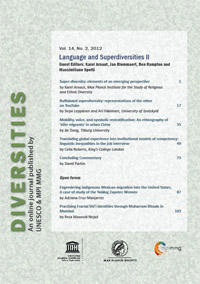From multilingual classification to translingual ontology: concluding commentary
by David Parkin
To cite this article: Parkin, D. (2012). From multilingual classification to translingual ontology: concluding commentary. Diversities, 14(2), 73–85. https://doi.org/10.58002/fxv3-zw03
This paper presents extensive commentaries and reflections on most of the papers in this special issue (with the exception of Arnaut’s contribution) as well as in the previous Language and Superdiversities special issue (Diversities 13/2). The papers of David Parkin and Karel Arnaut are both attempts to device new frames of reference for the sociolinguistic study of super-diversity. Here Parkin argues that the use of semiotic resources does not unambiguously classify social strata and ethnic groups but creates and draws from communicative outlines that cut across them and blur their contours. This has two consequences. One is that contemporary polylanguaging is an ontological act on the part of speakers to empower themselves or to project a desired or appropriate personal image, perhaps in accordance with some kind of network membership but not tied to a domain or topic in the broader sense given above. The other is that this creation of identity is through semiotic stylisation, which by nonstandard means projects new identities or reinforces existing ones.
|
